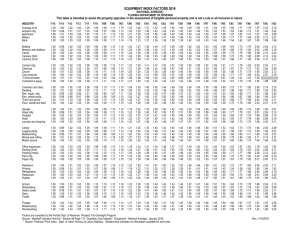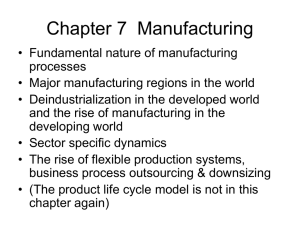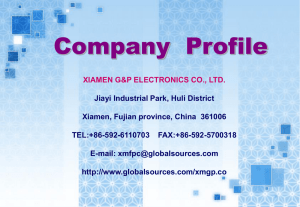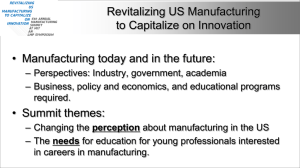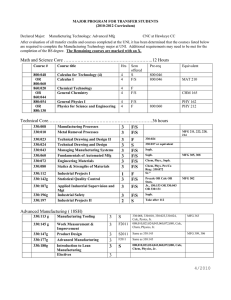Class Four: The Competitive Challenge in Advanced Production and Services
advertisement
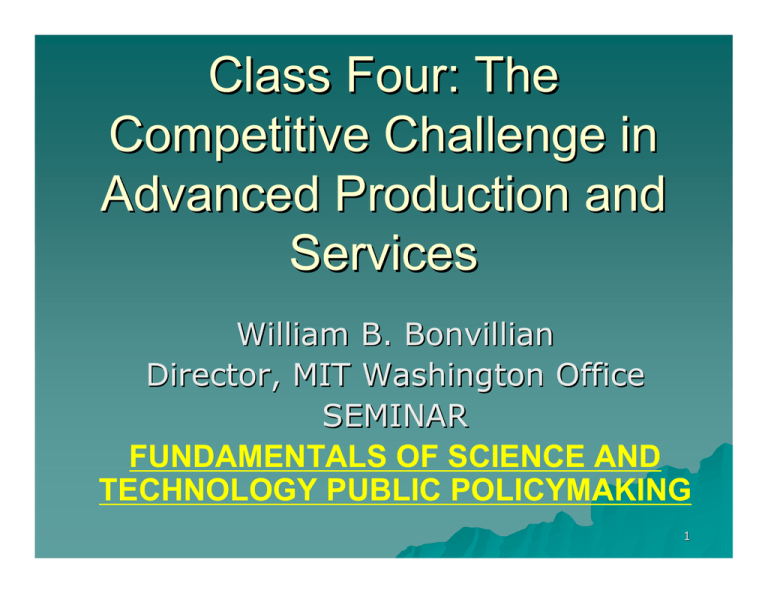
Class Four: The Competitive Challenge in Advanced Production and Services William B. Bonvillian Director, MIT Washington Office SEMINAR FUNDAMENTALS OF SCIENCE AND TECHNOLOGY PUBLIC POLICYMAKING 1 Brief Synopsis of of Class: Look at Manufacturing: way to profit from innovation -- historical review- Review of last competitiveness challenge to US mfg., 70-80’s, and how it responded in 90’s Comparative Advantage in Innovation Challenge The distributed manufacturing model Review of mfg. in Japan and Korea Tassey/Pisano/Shih – weaknesses in US mfg. Then – new competitive challenge from China, etc. The competition in services – software challenge Nature of competition is changing, too innovation in process as response? 2 PART ONE THE GLOBAL MANUFACTURING CHALLENGE 3 KENT HUGHES --Director, – Woodrow Wilson Center - Project on America and the Global Economy----- Expertise: International Trade, Finance, and the Global Economy; U.S. Competitiveness and Technology Policy Experience Associate Deputy Secretary of Commerce; President, Council on Competitiveness; Chief Economist Congressional Joint Economic Committee and to Senate Majority Leader, Robert C. Byrd Education Ph.D., Economics, Washington University in St. Louis; LL.B. Harvard Law School; B.A., Political and Economic Institutions, Yale University. Honors Woodrow Wilson Center Public Policy Scholar, International Legal Center Fellow 4 Kent Hughes, Building the Next American Century: The Past and Future of American Economic Competitiveness (Woodrow Wilson Press- Johns Hopkins Press 2005) 1970’s – US Faced: – Intractable inflation – Declining productivity growth; slow growth – Rising economic competition – Rising national anger, frustration with gov’t – US: unfettered markets, limited gov’t support for industry – Japan & Germany: controlled closed markets and major gov’t role with industry – LED TO: national competitiveness strategy 5 Initial Responses: (Hughes) Cong. Rep’s: Rep. Jack Kemp, Sen. Bill Roth, Pres. Reagan: reduce marginal tax rates Cong. Dem’s: industrial policy – reconstruction bank for lending to failing industries for turnarounds – later: focus on “sunrise” industries Then: “New Growth Compact:” Young Commission – John Young, CEO of H-P Focus on national competitiveness Fiscal and monetary policy creating favorable climate for investment Not only basic research but basic technology, industry led tech development policy and programs – “partnership nation” Rapid commercialization of technology – gov’t to support in labs, Univ’s and R&D programs 6 Hughes: New Growth Compact, Con’t. CRADA’s (Cooperation R&D Agreements with industry) at DOE Bayh-Dole at Univ’s (Univ’s get IPR’s for results of federally-funded R&D) ATP and MEP programs at Commerce Aim: End isolation between Univ’s and industry R&D efforts 12, Education – attempts to revamp K-12 esp. science & math Pro-international trade – led to Clinton ”compete not retreat”– NAFTA, China WTO Note: movement built on the Sputnik era and WW2 experiences of industrial-gov’t cooperation and common nat’l purpose 7 Japan and the Rebirth of Manufacturing (next slides drawn from Prof. C.Weiss) 60’s-70’s – Japan’s mfg. innovations reestablish mfg. as way to competitiveness Pre: 70’s - Quality-Price Trade-Off: – Mass Production Don’t stop the production line Inspectors throw out what isn’t quality Statistical quality control: find acceptable level of quality based on cost Definitions: – Quality – how good is the product – Quality Control – is each unit of equal quality? 8 Toyota Ends the Quality-Price Trade-Off: Toyota builds quality into the product – source: Demming – Every worker can halt the production line – Total quality control Just in time inventory – produce to order Integrate dealers and suppliers – long term partners in design and product improvement Japan’s best engineers start on factory floor, then move to design, not vice-versa Result: “Lean Manufacturing” More recently: Motorola- “Six Sigma” – GE mantra for all aspects of co. operations 9 Speeding the Product Cycle: Time is a competitive factor – so: Eliminate time delays Concurrent engineering design: – Ex.: Chrysler: late 80’s – Neon – fraction of Saturn dev. costs – Design in parallel, integrate design team – Factory floor manufacturability factor built into design – mfg. no long separated from design production starts, re--design design in real time as bugs are found Once 10 Labor Trade-Off Emerges in Japan: Lifetime employment makes labor a fixed cost Trade-off: flexible work/job def. accepted for lifetime work assurance Labor becomes collaborative not adversarial Labor accepts new technology and productivity gains US – auto industry was moving toward this model until competition with China 11 Industrial Policy Emerges in Japan: Prince Matsukata story – export orientation because resource poor MITI (Ministry of Int’l Trade and Industry) – “Japan Inc.” (now: “METI”) Keiretsu: integrated capital, trading, producersupplier firms – own each other – pre-WW2 model for rapid industrialization, retained postwar MITI adds gov’t support and trade policy to keiretsu model – Mistakes – Honda, aerospace – Honda, Sony - outliers Gov’t R&D focused on industry not Univ’s. – Comparable % of GDP as US, but US focused on basic research and defense R&D So: Japan lead in industrial R&D – Issue: incemental, not revolutionary/radical? 12 90’s US Response: Match Japan on mfg. quality Pursue “destructive/disruptive innovations” – Destroy/displace existing business models, technologies – Existing co’s can do radical innovation if existing customers seek improvements – Established firms move up-market and abandon low end – expands future profits – “destructive innovations” originate with lower end markets from outside existing competitor bases and improve until replace dominant – US did this radical innovation in 90’s with IT 13 US PURSUES INNOVATION, CON’T.: So -US pursues radical innovation –IT– in 90’s: – Rebuilds mfg. from 2nd class status – mfg. process is key, too – But now what? Globalization speeds product cycle and export of mfg. technology – Japan, then US face “hollowing-out” of their mfg. – Unlike US, Japan saves management control and advanced technologies – IT revolutionizes the service sector, high and low end 90’s – Japan faces macro-economic, population growth and banking problems; missed lead in IT, biotech revolutions 14 NOW WE JUMP AHEAD: Q: WHAT IS HAPPENING NOW, POST-90’S, TO US MANUFACTURING? - PART TWO - 15 BACKGROUND: Barry C. Lynn (Fellow, New America Foundation) End of the Line (2005) 16 Barry Lynn, End of the Line Con’t Hamilton: mfg. independence is key to American “independence and security” – made US independent from other nations Cold War- US pursued mfg. interdependence – integrated industrial complex from Europe to Japan - this promoted US independence Outsourcing: vertically integrate elements in mfg. process but divest control to spread risk – formerly domestic, now: international Now: participating nations: integrate their technology, capital and labor – control decentralized among participants – belongs to all participants and to none 17 Barry Lynn, End of the Line, Con’t Edward Lorenz (MIT meteorologist) – slight alternations in data would over time have dramatic effects –chaos theory “deterministic chaos” – way to make sense of complex, dynamic systems Labor Sec. Robert Reich – economic globalism is an unstoppable natural force – will crush the state but leave more room for the individual Thomas Friedman, NYT - globalism of cultures unstoppable, so can forge global community of interest Milton Friedman, Chicago Sch. of Economics – global marketplace as a sentient being, wisely directing human activity 18 William Greider – globalism is a bleak machine Barry Lynn, End of the Line, Con’t All: globalism equals an economic determinism akin to Marx ----- 3 Periods of US Economy: – Hamilton to 1945: rational national selfdependence in mfg. – 1945 – 1991 (end of Cold War) – US gov’t entwines US-Europe-Japan in mutual dependence on Amer-centric mfg. system – 1993 – Clinton- complete laissez-faire in mfg. – bind world into interdependent economic system tied by joint mfg. 19 Barry Lynn, End of the Line, Con’t China – West’s production system is merging with China’s Security Perspectives: – Integrationists: extending the West’s mfg. production system will bring China into the global economic system, benefiting US needs long term – Realists: profound differences in the two nation’s geopolitical goals and political systems remain – only question which nation gains the advantage from economic interdependence 20 BACKGROUND: Challenge to US Manufacturing Role of Manufacturing: 90’s – was 30% of US economic growth, 2x productivity of services sector Higher paying jobs – 23% higher in 2001 than services sector Current Mfg. Data: – Manufacturing remains an important part of the U.S. economy. It accounts for $1.6 trillion of U.S. GDP (12%) and nearly three-fourths of the nation’s industrial research and development. – Manufacturing firms account for 70% of US industry R&D and employs 64% of scientists/engineers – Manufacturing generated a greater percentage of real GDP in 2008 than real estate, finance, insurance, or health care sectors. – Manufacturing is also an enabler for the other sectors – each mfg job supports 2.5-5 other jobs throughout the U.S. economy. This contrasts with the retail sector, where every 100 jobs generate 94 new jobs elsewhere, and the personal service sectors, where 100 jobs create 147 new jobs. 21 US Mfg. Challenge, Con’t – This multiplier effect reflects how manufacturing’s linkages run deep into the overall economy and means that improvements in manufacturing productivity translate broadly into the economy as a whole. – Many service sector jobs are tied tightly to domestic manufacturing; their number will expand or contract with the size of the manufacturing base. – Must embrace new technologies, processes and efficiencies for productivity gain in manufacturing. Manufacturing is the currency of int’l trade, not services – but trade deficits – $812B in goods 2008 (surplus in services: $139B) - too big a gap for US int’l services sector to offset huge role of mfg. 22 Manufacturing, Con’t - Job Loss 2.7m job s los jobs lostt 7/00 to 9/03 6.7m jobs lost in 2008-09; majority appears to be mfg. Job creation still marginal 00 Recession - Mfg. 15% of non-farm labor force, but 90% of job loss – Mfg. fell from 13.27% to 11.4% of total labor force – Appears similar in current recession – But: C on C study - may be 46M jobs dependant on mfg Mfg. output as a share of US economy – falling for 50 years, 14.01% IN ’03 – Germany, 21% – Italy, 19% – Japan, 22% – South Korea, 31% Structural Recession now, not business cycle = permanent structural loss of jobs 23 Production is to employment like an hourglass: Image by John Morgan on Flickr. ÅInput employment – resources, suppliers, etc. ÅThe production moment – limited employment, but key to other stages ÅOutput employment – distribution, services, sales, repair, etc. 24 25 Paul A. Samuelson, Prof. Of Economics, MIT (Nobel Prize 1972), “Where Ricardo and Mill Rebut and Confirm Arguments of Mainstream Economists Supporting Globalization”, Jour. of Economic Perspectives, Vol. 18, No. 3 (Summer 04) Mainstream economists (Alan Greenspan, Jagish Bhagwati, Gregory Mankiw, etc.) argue re Globalization: “Yes, good jobs may be lost in the short run, but still total US net national product must by economic laws of comparative advantage be raised in the long run (and in China, too)…. Never forget the real gains of consumers alongside admitted possible losses of some producers in this working out of what Schumpeter called ‘creative capitalist destruction. Correct economic law recognizes that some American groups can be hurt by dynamic free trade. But correct economic law vindicates the word ‘creative’ destruction by its proof that the gains of the American winners are big enough to more than compensate the losers.” But Samuelson says: “The last paragraph can only be an innunendo For it is dead wrong about the necessary supply 26 of winnings over losings” Samuelson – Capturing Comparative Economic Advantage Q: How can the US be a loser in trade with a low cost, low wage competitor like China despite the Ricardo’s theory of “ comparative advantage”? A: Ex.: If China begins to make productivity enhancing gains in its production, and couples that with its low wages, it can capture some of the comparative advantage that belonged to the US through its productivity dominance [note: US still the most productive economy in the world] Then -- in a Ricardo analysis, there is never any unemployment that lasts forever from trade – “So it is not that US jobs are ever lost in the long run; it is that the new labor-market clearing real wages has been lowered by this version of dynamic fair trade.” In other words, US wages can drop after a time to a point where China’s productivity enhancement is offset. The US still has a benefit from lower prices for goods, but there are now “new net harmful US terms 27 of trade” Samuelson: Economic history is replete with the story of capturing comparative advantage: Example: Farming moves from east US to midwest two centuries ago Example: Textile and shoe mfg. moved from new England to the low-wage South early last century Example: English mfg. leadership shifted to the US starting in the middle of the 19th century “Even where the leaders continued to progress in absolute growth, their rate of growth tended to be attenuated by an adverse headwind generated from low wage competitors and other technical imitators.” 28 Samuelson’s Conclusions: So: “a productivity gain in one country can benefit that country alone, while permanently hurting the other country by reducing the gains from trade possible betwe en the two countries” – all this is “long between run Schumpeterian [the creative destruction of capitalism] effects” There is a “roulette wheel of evolving comparative advantage” in a world of free trade “Comparative advantage cannot be counted on to create…net gains greater than the net losses from trade” But if you respond with tariffs and protectionism, you may be breeding “economic arteriosclerosis” 29 Suzanne Berger (MIT), How We Compete (2005) Basic point - new “varieties of capitalism” emerging in digital era between U.S. and Asia in advanced tech goods IT is Driver: codeable specs enable a split between design and manufacturing – Previously, need for tacit knowledge kept these two closely tied together – Digital fragments the mfg. process, distributes it Model Airplane vs. Legos – Model plane - each kit a bit unique, everything has to fit, lots of gluing and sanding unique to each, whole process has to be integrated together – Legos - co’s can make different parts that are IT standardized that fit together - can split mfg. and 30 design, distribute mfg. Suzanne Berger, Con’t Ipod - the classic example - Apple picked a mix of MP3 best technologies, tied it to a new accessible and legal music database and now a video base – Crossover product -key: combined player and data – Stood up very fast because IT-standardized legos, the parts fit together - Apple doesn’t have to build its own mfg plant - great speed to market, competitive advantage – Apple provides core competence, contract manufacturers worldwide do the rest – Vertical integration not needed anymore - can distribute mfg. functions via IT specs 31 31 Suzanne Berger, Con’t US using Lego model - open network for innovation; can move innovation offshore Asia - contrasting model – Korea - Samsung controls key components, allows assembly offshore // Dell: final assembly, components made offshore – Japan - keeping integrated innovation model - and co’s very successful Building plants in China but keeping IP in a “black box” Japan keeps “mother factories” in Japan to innovate If integration capability and tacit knowledge are still key to radical innovation then Japan may have the right model Japan owns its plants in China, so it understands these markets on the ground, new US distributed mfg. model precludes this new market know- how Japan - talented production workforce is innovation process key; US treats workforce as disposable – Both models may work 32 Glenn R. Fong, “Follower at the Frontier: International Competition and Japanese Industrial Policy,” Int’l Studies Quarterly 42, 339-366 (1998) JAPAN’S INNOVATION RESPONSE TO THE US 3 Historical Stages to Japan’s competitive pattern: – – – “pursuer after pioneer”, THEN, “follower at the frontier”, THEN, “world class competitor” Old Thesis re: Japan: – National industrial performance and – Corresponding competitive balance between nations, is – Set by “national political economies” (gov’t role) 33 Fong-- MITI’s Evolution: MITI’s role parallels evolution of Japan’s own technology leadership role PRAGMATIC TECHNOLOGY INITIATIVES: – Older Period: specifically selected by high-level gov’t leaders – Recent Period: now – industry selected, collaboratively with participation of lowlevel officials close to industry (because high level officials can’t keep an eye on rapidly evolving complex technologies) 34 Fong-- MITI’s Evolution, Con’t.: TECHNOLOGY TARGETING: – OLDER PERIOD: direct gov’t targeting of one or two specific technologies Funded at late development stages prototyping and engineering development stages – NEWER PERIOD: shift toward BASIC research funding as well as applied, – of broad range of alternative technologies supported -– “shotgun” not a “rifle shot” 35 Fong -- MITI’s Evolution, Con’t.: INDUSTRY TARGETING: – OLDER PERIOD: MITI picked winner co’s by designating specific co’s for funding Influenced corporate mergers to force development of strong co’s –NEWER PERIOD: MITI funds range of co’s and collaboration models Over 30 year period, MITI goes from funding 3 firms, to 25 firms in key computing initiatives 36 LINSU KIM, “IMITATION TO INNOVATION” (Harvard Bus. Sch. Press 1977) 37 Elements in the Evolution of Korea to High Growth Economy: (Kim) By 60’s, Korean firms on a “leadership trajectory” – Elements: Gov’t – “forced march industrialization” – Gov’t supplies education through college – Demand side – created chebols (cartels of dominant firms) – But: Corruption – made gov’t highly uncertain factor for business Strong gov’t – asset in early stage; later, rigid bureaucracy inhibited market responses Chebols – key to capturing large scale industries -- – But took toll on free market by blocking Small and Medium enterprises (SME’s) – Problem misallocation of resources, inefficiency 38 Elements in Korea’s Growth Economy, Con’t.: (Kim) Education – widespread education – leges but failure to evolve beyond col colleges to research universities Export Strategy – created business opportunities, exposed firms to lifeor-death world competition crises – this built competitive strength – Gov’t available to help in these crises Tech Transfer Policy – policy was largely reverse engineering of foreign technology – critical capability 39 Elements in Korea’s Growth Economy, Con’t: (Kim) R&D Policy – since no Korean resea rch univ. research base, gov’t R&D centers become key – Gov’t Research Institute’s (GRI’s) led by Korean Institute for Sci and Tech (KIST) – Gov’t efforts to force joint GRI-industry R&D failed in early stages – But GRI’s did contribute experienced researchers to industry – critical Cultural Factors – – Merger of Confusian culture (of family and collective orientation), and Christianity (pragmatic, goal-oriented individual values) – Korean War left country destroyed, with nothing – major north-south exodus amalgamated people form different regions, economic levels, and families – created flexibility – Universal military service – group management, strong organization broke down class lines 40 Elements in Korea’s growth Economy, Con’t.: (Kim) Learning Tech Culture – firms go from: Poaching, to Reverse Engineering, to R&D, to Innovation R&D Investment – – Heavy R&D investment by industry chebols – But: no SME’s to spur out of the box innovation, only relentless world competition – Korea – very high R&D to GDP ratio: Korea, 24% Taiwan, 15.8% Singapore, 22.3% Spain, 11.4% Japan, 7.4% 41 Problems for Korea: (Kim) Limited university R&D Needs SME/entrepreneurial base Needs network of technical support (mfg. extension programs) Needs liberalized economy away from domination by small elite and chebols Chebols need downsizing, decentralizing, and democratization of workforce Lessons From Korea: Strong gov’t leadership role – created chebols and force them into competition worldwide Gov’t education programs facilitated tech learning by industry Gov’t used crisis creation to force firms to compete effectively worldwide 42 Greg Tassey (NIST): Trends in Manufacturing (2010) U.S. national R&D intensity same as in 1960, while other competitive economies have steadily increased their intensity – Input/Output theory: Freeze a major input, limit growth – (Intensity: defined as R&D spending relative to GDP) Although domestic corporate R&D spending increased relative to GDP for most of this period, ratio now in decline Major reason: U.S. manufacturing firms have dramatically shifted their R&D investments strategies during the last twenty years toward an increasingly global scope. – U.S. manufacturing firms increased offshore R&D at three times the rate of domestic R&D spending U.S. manufacturing firms have shifted composition of their R&D portfolios toward shorter-term development objectives. – The “valley-of-death” (barriers between investment in radical or breakthrough research for new technologies, with strong long-term potential, and development) is widening43 . National R&D Intensities, 2005 Gross R&D expenditures as a percentage of GDP 4.49 3.89 3.48 3.33 2.98 2.90 2.78 2.62 2.48 2.46 2.25 2.13 1.98 1.74 China EU-27 Ave Canada France OECD Ave Taiwan Germany United States Iceland Switzerland Korea Japan Finland Sweden Israel 1.33 Image by MIT OpenCourseWare. 44 Greg Tassey, Mfg. Trends, Con’t Over 50 years (1957-2007), manufacturing’s share of GDP has shrunk from 27% to 12% For most of this period (1965 (1965--2000), manufacturing employment remained constant at 17 million Last decade, mfg. employment fell to around 12 million – Note: mfg. employment measurement issue: that is the no. of jobs in actual production phase, not industrial employment Value of manufacturing output (shipments) in constant dollars grew due to productivity growth but, constant-dollar shipments remained flat (2000-2007), although still world leading with 22% of world output – But: Atkinson (2009): US mfg. output value data significantly overstated since it includes a productivity factor for IT goods – not real estimate of real output 45 Will Services Make up for Mfg. Decline? Our economy is already 80% service, just continue the trend One indicator – trade deficit Pre recession – end of 2007, trade deficit in mfg. goods ~$420B/yr, trade surplus in services ~$160B/yr Growth in services surplus dwarfed by the size of the deficit in goods – it will not offset it anywhere in foreseeable future 46 Courtesy of Christopher Snyder. Used with permission. 47 Gary Pisano and Willy Shih (HBS 2009) The US: “Kindle 2” could not be made in the – Flex circuit connector – China – Electrophoretic display – Taiwan – Controller – China – Lithium polymer battery – China – Wireless card – China – Injected molded case – China Eroding US ability to create: – every brand of US notebook computer (except Apple) and mobile/handheld designed in Asia 48 Pisano and Shih, Con’t Advanced abroad: Technology at risk of shifting – Advanced materials: Gone: advanced consumer composites, advanced ceramics, IC packaging At Risk: carbon composite components for aerospace/wind – Computing and Communications: Gone: desktop, notebook, netbook PC’s, low end servers, hard disk drives, routers, home network tech At Risk: midrange servers, blade servers, mobile handsets, optical comm. equipment, core network 49 equipment BACKDROP: Economic Realities Forcing New U.S. Public Policy: Economy facing major structural changes – ----globalization challenges ----lo ss of both mfg. & outsourcing IT services loss ----companies recover without creating jobs ----major demographic shift – ----what will a new economy look like? threatening process… 50 Payroll Job Growth in Recoveries Percentage Change From Trough 8 7 6 5 4 3 2 1 0 -6 -3 ug -9 3 6 Tr o -12 h -1 9 12 15 18 21 24 27 30 Months Average of Previous Recessions Early 90's Current Image by MIT OpenCourseWare. BLS data – Cited: E.Milbergs, Innovation Metrics, NII, 1/2004 Sources: U.S. Bureau of Labor Statistics; authors’ calculations. Note: The shaded area indicates the length of the 2001 recession. 51 Number of Jobs Lost to Structural vs. Cyclical Change in Recessions 49% 51% 49% Mid - 70's 51% Early - 80's 21% 43% 57% 79% Early - 90's Current Cyclical BLS Data; Cited In E.Milbergs, Innovation Metrics,NII, 1/2004 Structural Image by MIT OpenCourseWare. 52 Contribution to GDP Growth: Business Investment vs. Other Factors 6 5 4 3 2 1 0 -1 1992 1993 1994 1995 1996 1997 2003 1998 1999 -2 -3 2000 2002 2001 Government Business Investment Consumption Trade G overnment Image by MIT OpenCourseWare. Source: H. Rosen, 3/04 53 Investment in Plant, IT and Equipment 1960- 2003 16 Plant 14 Information Technology Equipment Percent of GDP 12 10 8 6 4 2 0 1960 1965 1970 1975 1980 1985 1990 1995 2000 Image by MIT OpenCourseWare. Source: H. Rosen, 3/2004 54 COMPETITIVENESS THEN AND NOW: Japan: High-cost, high-wage, advanced tech - “just like us” We have Entrepreneurial advantage, they have Industrial Policy advantage Rule of Law IP Protections Subsidized currency, buying our debt National Security: allies China: New Mix Low-cost, low-wage, advanced tech Entrepreneurial Using Industrial Policy Limited Rule of Law Almost no IP protection model Subsidized currency, buying our debt Nat’l security – peer competitor 55 Now, PART THREE – the Services side -- Increasingly services will be globally competitive because of IT India: new model – entering global competitiveness in IT-based services – unlike any other emerging n ation nation model 56 William J. Raduchel (VP, CTO, AOL-Time Warner, former CSO, Sun), “The Economics of Software” (2004-draft report for National Academies of Sciences STEP Board) Software: core of most modern organizations Largest single class of assets in the world Operating, maintaining and creating software is the largest class of expenses for the modern corp. other than direct labor Software and the business practices it supports are the biggest driver of productivity growth “Software embodies the knowledge and practice by which the organization performs its mission, and consists of both design and implementation” Software determines the enterprise planning systems that set how a factory will run 57 Raduchel – Key Role of Software Harvard economist Dale Jorgenson: for most OECD economies software was the major source of increased investment in knowledge during the past decade US Labor Dept. Bur. of Labor Stat’s anticipated that 8 of the 10 fastest US occupations will be computer related, with software engineers comprising the largest group --This prediction is at risk given the way India and China are upgrading their economies by outsourcing these jobs from the US, where computer science continues to decline in popularity as a field of study A firm is an information system – of highly decentralized computing by fallible agents (people) -software defines the information system, so the value of a firm is largely embedded in its information system 58 Raduchel – Software Looks Easy but the problem is making it error free, robust against change, scaleable to high volumes, and seamlessly integrated with many other firm software system in real time The software stack on a modern PC is probably the most complex good every created by man – average corporate IT system is far more complicated than the Space Shuttle or Apollo project Bill Joy – the spiraling complexity of putting “Star Wars” scale software on the desktop There is no other item we own that is as confusing and unreliable as our PC – the hardware works well, it’s the software 59 Raduchel - Software is a “Stack” Software is a “stack” composed of multiple layers of software created by different teams over time for different purposes and brought together for the unique task at hand Picture a stack of IBM punch cards and you drop them individual parts of the software don’t matter, it’s the entire stack – and EVERY part of the stack has to function very well otherwise it’s worthless Stack has to be in perfect order or the system fails 60 Raduchel – software development: -The best software developers are orders of magnitude better than the average developer -About 100 to 200 developers worldwide end up writing the software we use -Maurice Halstead: one attribute of the human brain drives programming ability no one can solve a programming problem he or she can’t understand Average developer has about 250 “Halstead lengths” Wizard programmers have Halstead lengths of 65,000 Economics of software: -Different from anything else -Not a factor of production like labor or capital -Instead it defines the production function -It improves by making itself more complex - raising risk of catastrophic loss -Economists, lawyers, accountants don’t properly value or account for software -It is a tool without value in itself, but it creates huge potential value through in the systems it is built for -We account for it as a periodic expense but in reality it61 adds assets and liabilities Raduchel – Making Software: The specification for the software is without meaning – the only specification is the stack itself Quality of the designer is 90% of the quality of the software design Best way to cut software costs and improve features is to increase the quality of the designer Cutting the development schedule requires a many fold increase in staff Adding more staff guarantees later delivery Value of software is often unrelated to cost Cost of maintaining and modifying software increases over time and with accumulated changes Has to be replaced every 7 to 10 years because of accumulated changes and platform evolution Source code, is the least valuable part of software so giving it away is good strategy because it is irrelevant and can promote new innovation [IBM-Microsoft Linix 62 vs. Windows open source battle] Software – both value and liability enabler Software programming phase is only 10% of the software – the implementation is an intangible asset of potentially enormous value -its value grows with the operations and prospects of those business operations – it is also a huge potential liability 63 CLOSING THOUGHTS: Joel Moses (MIT) - 3 Fundamental Design Methodologies (2004) There are 3 Fundamental, Different Design Methodologies: Historically US has used “TREE-AND-BRANCH” hierarchial firms – Fit a mass production economy – mfg. at a nat’l scale for a nat’l market, verticle integration required - think Big 3 car co’s – Fit an Aristotilian hierarchy of ordered knowledge This is still the way the West orders science – But the tree hierarchy meant inflexibility and slow 64 to change Joel Moses, Con’t In contrast, Japan’s enterprises of 70’s-80’s and now were “LAYERED” – separate but connected ranks, movement and connections between ranks, but no title status – Ex.: Plato’s philosopher king, guardians, citizens In the 90’s the US nurtured a new “NETWORKED” flatter, set of enterprises – Driven by the IT sector - demand for flexibility and speed to market – Driven by the collaborative group innovation systems behind IT – these appeared even more flexible and faster than “layered” systems NOTE: Engineering: lacks model to grasp these emerging structures 65 AND NOW ANOTHER FACTOR- The Nature of the Competition is Changing Then: manufacturing / Now: fusion of services and manufacturing Then; Quality / Now: customization,speed, customer responsiveness Then: best technology / Now: technology plus business model Then: trade in products / Now: trade in knowledge management and services Then: worker skills / Now; continuous learning Then: low cost capital / Now: efficiency in all financial services stages, plus 66 intangible capital Class Four - Wrap-Up: Kent Hughes – US built comparative advantage in the 80’s-90’s by becoming innovation hub, bringing on IT revolution – Behind this, advantages in R&D, education; added partnership model Japan’s Competitive Pattern – Innovated with mfg. process – quality, just in time inventory, supply chain integration, gov’t participation, etc. Paul Samuelson – Comparative advantage in innovation can shift unlike a resource advantage – Free trade theory has to acknowledge this reality 67 Wrap-Up, Continued Suzanne Berger – Nature of manufacturing competition changing U.S. separating design and mfg. for distributed mfg. model and fast product standup - ipod Japan/Taiwan firms retaining integrated model to learn local markets Glenn Fong – MITI advanced with Japan’s economy – pursued more sophisticated industry role – let industry lead, played supporting function, stopping winners, backed basic research as well as applied Linsu Kim–Korea emerges - factors: – Gov’t: “Forced march industrialization” – Chebols – Education – esp. through college – Merciless Export Strategy for co’s – Tech Transfer is Reverse Engineering – R&D via Gov’t Research Institutes 68 – Culture – collective & individual; diversity Wrap-Up, Con’t Greg Tassey, NIST U.S. national R&D intensity same as in 1960, while other competitive economies have steadily increased their intensity – Input/Output theory: Freeze a major input, limit growth – (Intensity: defined as R&D spending relative to GDP) Although domestic corporate R&D spending increased relative to GDP for most of this period, ratio now in decline Major reason: U.S. manufacturing firms have dramatically shifted their R&D investments strategies during the last twenty years toward an increasingly global scope. – U.S. manufacturing firms increased offshore R&D at three times the rate of domestic R&D spending Gary Pisano, Willy Shih, HBS – U.S. loss of advanced technology production capability – Kindle story 69 Wrap-Up, Continued: Post-90’s – What happens to US Mfg.? – 01-03 “Recession” – 2.7m permanent structural job loss in manufacturing – Similar totals expected in current recession – Disinvestment in plant and capital equipment Manufacturing Challenges – Manufacturing is currency of int’l trade – Way nations profit from innovation – Mfg. firms employ most scientists/engineers, sponsor most R&D – US mfg. employment now in decline – big part of 08-09 job loss of 6.7 – this is structural unemployment – Health of US mfg. base starting to decline, as well 70 Wrap-Up, Con’t Services: – Global competition in services emerging – IT/internet enabled – India organizing new model Raduchel – Software – central value of the modern firm – Now subject to global competition – India – software focus for growth Closing thoughts: Joel Moses – Three fundamental design methodologies Hierarchial Layered Networked And – nature of mfg. competition changing71 BIG CHALLENGE - How can US stay in manufacturing, a key to wealth? Growth Economics says only one move: Innovate the Process Revolution in Manufacturing – MIT Study – distributed mfg., – network centric/robotics, – desktop mfg., – inspection simultaneous with production, small lot production as cheap as mass production, – revolutionary materials, – nano mfg. technology DOD has big stake in retaining US manufacturing capacity – DOD role in supporting mfg. process revolution? – DARPA, NIST, DOE, NSF coming together72 MIT OpenCourseWare http://ocw.mit.edu Resource: Science Policy Bootcamp William Bonvillian The following may not correspond to a particular course on MIT OpenCourseWare, but has been provided by the author as an individual learning resource. For information about citing these materials or our Terms of Use, visit: http://ocw.mit.edu/terms.
